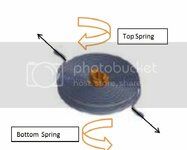Instala la aplicación
How to install the app on iOS
Follow along with the video below to see how to install our site as a web app on your home screen.
Nota: This feature may not be available in some browsers.
-
El foro de relojes de habla hispana con más tráfico de la Red, donde un reloj es algo más que un objeto que da la hora. Relojes Especiales es el punto de referencia para hablar de relojes de todas las marcas, desde Rolex hasta Seiko, alta relojería, relojes de pulsera y de bolsillo, relojería gruesa y vintages, pero también de estilográficas. Además, disponemos de un foro de compraventa donde podrás encontrar el reloj que buscas al mejor precio. Para poder participar tendrás que registrarte.
Estás utilizando un navegador obsoleto. Puede que este u otros sitios no se muestren correctamente.
Debes actualizarlo o utilizar un navegador alternativo.
Debes actualizarlo o utilizar un navegador alternativo.
Serie de traseras y delanteras. Capítulo 1. Moser Perpetual 1
- Estado
- Hilo cerrado
Doncainastyle
Weiser Uhrmacher
Sin verificar
De olvidastes una cosa de este reloj muy imporante o por lo menos diferente a todos lo demas. El sistema de escape, volante, rueda de ancora y ancora esta montado en una pequena platina que se puede quitar entero. El motivo es algo marketing-tecno pero unico en el mercado.
La cabeza detras de los MOSER es por gran parte ANDREAS STREHLER de Winterthur que inventado mucho de este reloj y lo fabricado muchas piezas para realizar el reloj.
La fecha con los dos discos superpuestas venia en el ano apr.2000 de Paul Gerber en Zurich que lo tenia patentado. Poco despues un relojero aleman y un suizo han copiado la fecha por que ya existido un patente de los anos 40. Con este patente viejo el de Gerber era sin valor. Moser adaptado tambien la fecha despues de los tres otros relojeros. De mi punto de vista el mejor fechador del mercado y el mas grande. Mucho mejor y bonito que el de Lange y de Glashütte con los discos alado.
Precioso reloj de verdad. ENHORABUENA
La cabeza detras de los MOSER es por gran parte ANDREAS STREHLER de Winterthur que inventado mucho de este reloj y lo fabricado muchas piezas para realizar el reloj.
La fecha con los dos discos superpuestas venia en el ano apr.2000 de Paul Gerber en Zurich que lo tenia patentado. Poco despues un relojero aleman y un suizo han copiado la fecha por que ya existido un patente de los anos 40. Con este patente viejo el de Gerber era sin valor. Moser adaptado tambien la fecha despues de los tres otros relojeros. De mi punto de vista el mejor fechador del mercado y el mas grande. Mucho mejor y bonito que el de Lange y de Glashütte con los discos alado.
Precioso reloj de verdad. ENHORABUENA
S
sanro
Milpostista
Sin verificar
De olvidastes una cosa de este reloj muy imporante o por lo menos diferente a todos lo demas. El sistema de escape, volante, rueda de ancora y ancora esta montado en una pequena platina que se puede quitar entero. El motivo es algo marketing-tecno pero unico en el mercado.
La cabeza detras de los MOSER es por gran parte ANDREAS STREHLER de Winterthur que inventado mucho de este reloj y lo fabricado muchas piezas para realizar el reloj.
La fecha con los dos discos superpuestas venia en el ano apr.2000 de Paul Gerber en Zurich que lo tenia patentado. Poco despues un relojero aleman y un suizo han copiado la fecha por que ya existido un patente de los anos 40. Con este patente viejo el de Gerber era sin valor. Moser adaptado tambien la fecha despues de los tres otros relojeros. De mi punto de vista el mejor fechador del mercado y el mas grande. Mucho mejor y bonito que el de Lange y de Glashütte con los discos alado.
Precioso reloj de verdad. ENHORABUENA
Cierto, Doncainastyle, todo el sistema del escape es "extraible". Ademas de marketing-techno, esto es muy util a efectos de reparación... No hay que desmontar el calibre entero para llegar al "corazón", como pasa en otros relojes complicados.
Gracias por tu aportación.
 :
:
S
sanro
Milpostista
Sin verificar
Voy a intentar hacer un copy & paste de una explicación muy detallada del double-hairspring (esta en ingles) para el que le pueda interesar, y para que quede aquí recogida. Perdonadme porque es un poco "tostón", aunque muy interesante.
The Tourbillion is aesthetically and visually more appealing and most people like the way it looks (even though they don't understand it) and is visually more 'grand' and legitimate complication looking (apologise for the weird language, cant really put it in words)
The Double Hairspring escapement at first glance seems to people as ordinary as any regular escapement though technically it seems sound in principle.
Had quizzed an independent watch maker (cannot name the same) and they sent the following (see below)
As far as my limited knowledge in horology and physics allows me, my understanding is that for an Tourbillion to effectively negate the forces of gravity at various positions the watch might turn inot has a few caveats.
For e.g. - a 60 second tourbillion - the escapement has to complete one complete cycle (60 seconds) for it to effectively work, if the tourbillion escapemet moves around within the 60 second cycle it effectively cancels out the use of the cage.
Where as in the double hairspring escapement , due to the paired hairsprings negating the inertia of each other in a continues cycle and the center of gravity alternating between the two springs works in almost any position.
In the diagram below, it seems that the gravitational influence on an escapement with a Straumann Double Hairspring is miraculously low !
Straumann double hairspring
In any watch movement, the balance wheel and its hairspring are subject to gravitational forces that influence their rate and therefore the accuracy of the watch. That is especially true with a flat hairspring, like a Straumann.
Several ways of compensating these effects have been followed during the history of watchmaking.
One was to act on the hairspring directly, either on its shape (cylindrical or spherical hairsprings) or on its attachment to the balance and to the stud, with terminal curves (best known, the Breguet overcoil).
A second way, also compensating for the effect of gravitation on the balance itself, was to mount the entire escapement device (balance wheel, hairspring, pallets, escape wheel) on a rotating carriage which is known as “tourbillon” or “carrousel”.
The double hairspring. Two hairsprings on top of each other and their spirals are opposed (one turning clockwise the other anti-clockwise). So when the hairsprings are beating, they expand and contract in the opposite direction to each other. When the gravity center of the lower hairspring moves to the right, the gravity center of the upper one moves the same amount to the left, compensating each other and keeping the gravity center in the center of the balance wheel. Thus guaranteeing that timing accuracy is the same in every position on the wearers wrist.
See the graphic underneath to view the movement of the gravity center of different hairsprings.

Moser's Double Hairspring escapement with two opposing Straumann Hairsprings prevent the gravitational error from occurring in the first place.
In a watch, the gravitational error disrupts the stability of its accuracy. This means that when the watch is in a horizontal position – i.e. when the dial is at the top – the watch runs differently than when the dial is positioned vertically, i.e. laterally. The watchmaker counteracts this phenomenon by adjusting the watch so that the slower vibrations of the
balance in vertical position are compensated for as precisely as possible by the more rapid vibrations in the horizontal position. This produces an average level of accuracy, although this is dependent on the way in which the owner wears his watch. This is because the average level of accuracy is only achieved if both positions occur with approximately the same frequency. In practice, the vast majority of watches are therefore adjusted in fi ve standardized positions in order to minimize the discrepancies. At Moser we pursue this practice to the limit, as we adjust our watches in all six possible positions. So where, then, does this gravitational error come from? And how can we reduce its impact even further?
These questions have preoccupied watchmakers for many decades. In this respect, it is important to know the type of attachment at the outer end of the balance spring. This is realized either by a flat curve or a Breguet curve. The socalled flat curve, which is used in most mechanical watches, can be implemented very easily. It does, however, present the disadvantage that the balance spring assumes an asymmetrical shape when it vibrates. In doing so, the centre of gravity in the spring moves away from the middle. If we now imagine that the spring adopts a vertical position, it then becomes clear that due to the shift in the centre of gravity, the vibrations in the “downward” direction are accelerated by the earth’s gravitational pull. At the same time, vibrations in the “upward” direction are impeded, and consequently slowed down. On the other hand, if the spring is in a horizontal position, this effect does not play a role. This is not a good starting position for the stability of the accuracy.
In contrast, the Breguet curve was developed in order to avoid precisely this asymmetrical vibration of the fl at curve. It does this by ensuring that the outer end is curved upwards over the high edge, and is then further curved inwards. This task demands all the skills and ability of the adjusters, since the procedure is predominantly carried out by hand. This complicated and from the point of view of craftsmanship highly demanding form of manufacture is the reason why the Breguet curve is only found in watches of very high quality. As a result, the vibrations of a spring with a Breguet curve are almost completely symmetrical. But only almost. There is still a small residual error.
The approach to the double hairspring escapement with a pair of Straumann hairsprings is now very simple: the springs are arranged one above the other, with one vibrating to the left and the other vibrating to the right. If both springs have the same mechanical characteristics, then when they vibrate, the centre of gravity moves outwards from the centre – just as it does with a single spring and a flat curve. However, as both springs are vibrating asymmetrically in opposite directions as a result of the different direction of rotation, the centre of gravity, on average, remains exactly in the centre. A gravitational error due to the asymmetrical vibrations of the springs can therefore not occur in the first place.


The Tourbillion is aesthetically and visually more appealing and most people like the way it looks (even though they don't understand it) and is visually more 'grand' and legitimate complication looking (apologise for the weird language, cant really put it in words)
The Double Hairspring escapement at first glance seems to people as ordinary as any regular escapement though technically it seems sound in principle.
Had quizzed an independent watch maker (cannot name the same) and they sent the following (see below)
As far as my limited knowledge in horology and physics allows me, my understanding is that for an Tourbillion to effectively negate the forces of gravity at various positions the watch might turn inot has a few caveats.
For e.g. - a 60 second tourbillion - the escapement has to complete one complete cycle (60 seconds) for it to effectively work, if the tourbillion escapemet moves around within the 60 second cycle it effectively cancels out the use of the cage.
Where as in the double hairspring escapement , due to the paired hairsprings negating the inertia of each other in a continues cycle and the center of gravity alternating between the two springs works in almost any position.
In the diagram below, it seems that the gravitational influence on an escapement with a Straumann Double Hairspring is miraculously low !
Straumann double hairspring
In any watch movement, the balance wheel and its hairspring are subject to gravitational forces that influence their rate and therefore the accuracy of the watch. That is especially true with a flat hairspring, like a Straumann.
Several ways of compensating these effects have been followed during the history of watchmaking.
One was to act on the hairspring directly, either on its shape (cylindrical or spherical hairsprings) or on its attachment to the balance and to the stud, with terminal curves (best known, the Breguet overcoil).
A second way, also compensating for the effect of gravitation on the balance itself, was to mount the entire escapement device (balance wheel, hairspring, pallets, escape wheel) on a rotating carriage which is known as “tourbillon” or “carrousel”.
The double hairspring. Two hairsprings on top of each other and their spirals are opposed (one turning clockwise the other anti-clockwise). So when the hairsprings are beating, they expand and contract in the opposite direction to each other. When the gravity center of the lower hairspring moves to the right, the gravity center of the upper one moves the same amount to the left, compensating each other and keeping the gravity center in the center of the balance wheel. Thus guaranteeing that timing accuracy is the same in every position on the wearers wrist.
See the graphic underneath to view the movement of the gravity center of different hairsprings.
Moser's Double Hairspring escapement with two opposing Straumann Hairsprings prevent the gravitational error from occurring in the first place.
In a watch, the gravitational error disrupts the stability of its accuracy. This means that when the watch is in a horizontal position – i.e. when the dial is at the top – the watch runs differently than when the dial is positioned vertically, i.e. laterally. The watchmaker counteracts this phenomenon by adjusting the watch so that the slower vibrations of the
balance in vertical position are compensated for as precisely as possible by the more rapid vibrations in the horizontal position. This produces an average level of accuracy, although this is dependent on the way in which the owner wears his watch. This is because the average level of accuracy is only achieved if both positions occur with approximately the same frequency. In practice, the vast majority of watches are therefore adjusted in fi ve standardized positions in order to minimize the discrepancies. At Moser we pursue this practice to the limit, as we adjust our watches in all six possible positions. So where, then, does this gravitational error come from? And how can we reduce its impact even further?
These questions have preoccupied watchmakers for many decades. In this respect, it is important to know the type of attachment at the outer end of the balance spring. This is realized either by a flat curve or a Breguet curve. The socalled flat curve, which is used in most mechanical watches, can be implemented very easily. It does, however, present the disadvantage that the balance spring assumes an asymmetrical shape when it vibrates. In doing so, the centre of gravity in the spring moves away from the middle. If we now imagine that the spring adopts a vertical position, it then becomes clear that due to the shift in the centre of gravity, the vibrations in the “downward” direction are accelerated by the earth’s gravitational pull. At the same time, vibrations in the “upward” direction are impeded, and consequently slowed down. On the other hand, if the spring is in a horizontal position, this effect does not play a role. This is not a good starting position for the stability of the accuracy.
In contrast, the Breguet curve was developed in order to avoid precisely this asymmetrical vibration of the fl at curve. It does this by ensuring that the outer end is curved upwards over the high edge, and is then further curved inwards. This task demands all the skills and ability of the adjusters, since the procedure is predominantly carried out by hand. This complicated and from the point of view of craftsmanship highly demanding form of manufacture is the reason why the Breguet curve is only found in watches of very high quality. As a result, the vibrations of a spring with a Breguet curve are almost completely symmetrical. But only almost. There is still a small residual error.
The approach to the double hairspring escapement with a pair of Straumann hairsprings is now very simple: the springs are arranged one above the other, with one vibrating to the left and the other vibrating to the right. If both springs have the same mechanical characteristics, then when they vibrate, the centre of gravity moves outwards from the centre – just as it does with a single spring and a flat curve. However, as both springs are vibrating asymmetrically in opposite directions as a result of the different direction of rotation, the centre of gravity, on average, remains exactly in the centre. A gravitational error due to the asymmetrical vibrations of the springs can therefore not occur in the first place.
Archivos adjuntos
C
chimico01
Forer@ Senior
Sin verificar
- Estado
- Hilo cerrado






 . Me gusta mucho
. Me gusta mucho .
.

